Nevada Cowboys Ride Onto the Big Screen
January – February 2020
New movie takes an authentic, in-depth look at the working-ranch lifestyle.
BY JOLYN YOUNG
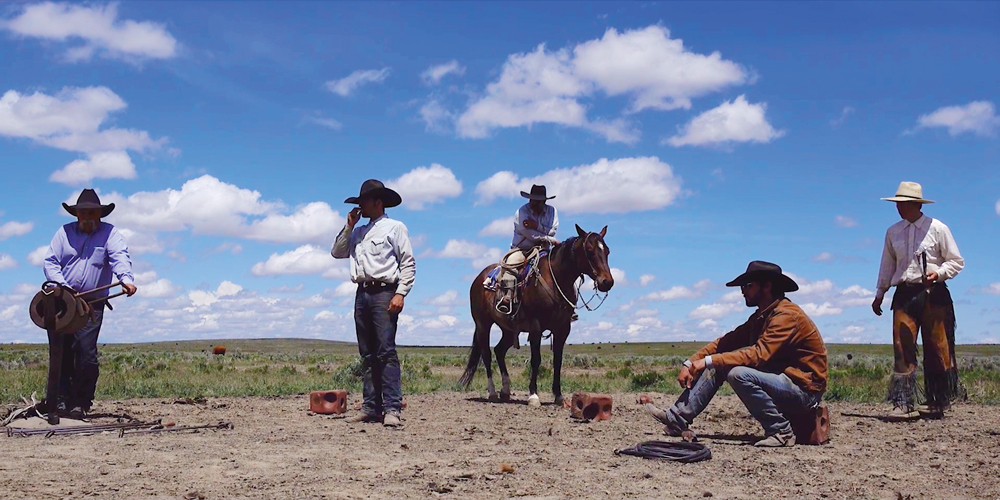
A cowboy trots briskly across an expansive meadow, riding toward an unknown destination. He is a solitary figure in a black hat and brown chaps, accompanied only by his horse. The meadow they quickly cover provides feed for the ranch’s cattle and is flanked by snow-capped mountains that showcase the vastness of Nevada’s open country.
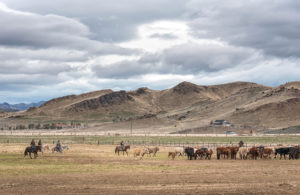
Ranchers, urbanites, and all others interested in the cowboy way of life can ride along with this Nevada buckaroo and other working cowboys featured in “Cowboys: A Documentary Portrait.” This feature-length film chronicles life on a modern-day ranch, as portrayed and narrated by the cowboys themselves. Filmmaker Bud Force and acclaimed photographer John Langmore teamed up with creative producer Felicitas Funke to tell the story of the cowboys and their families who make a living—and a life—in the saddle and on the range.
The cowboy culture is an integral part of Nevada’s history. The term buckaroo originated from the word vaquero, which is Spanish for cowboy. In the 1600s, vaqueros traveled from Spain to the New World and they used their specialized methods of riding and roping to help settle California. From there, the vaquero ways traveled to Nevada, where they rooted firmly with the Great Basin buckaroos during the mid-1800s.
Today, a strong buckaroo presence continues to thrive in Nevada. Cattle ranching, and subsequently cowboys, remain a pillar of the state’s economy in its vast rural regions. Here, tourists seeking an authentic Western adventure can experience all things cowboy, from family-owned saddle shops to ranch rodeos.

RIDING ONTO THE BIG SCREEN
This new film covers all four seasons and every aspect of ranch life, from pulling calves in the spring to feeding hay in the winter. The muted smell of sagebrush after a rainstorm, the lazy swirling of roll-yer-own smoke drifting skyward, the bawling of cattle in the corrals at shipping time, the rhythmic force of a bronc ride—these scenes and more come alive during the film.
“The audience is going to ride side-by-side with the cowboys and learn not only their day-to-day workings, but also their personal stories and challenges unique only to this lifestyle,” says Bud.
In order to accurately depict life on a modern-day big outfit, the directors chose to film only on ranches that run full cowboy crews in eight Western states, including three ranches in Nevada. Many ranches have stopped using horses and cowboys in favor of four-wheelers and hydraulic chutes. Force and Langmore carefully selected filming locations to capture the traditional Western lifestyle they sought to portray.
The film’s overall impact far exceeds practical education, though.
“I would consider it a biopic about this singular character being the ‘cowboy,’ but as told by multiple people who are each in essence that same character,” says Bud.
“Cowboys” deconstructs the romantic notions of the cowboy lifestyle typically portrayed by Hollywood movies and paperback novels. Throughout the film, working cowboys explain ranch work and their dedication to the lifestyle in their own words. They hail from different states and represent different stages of life, but they all share a common quality: They answered the call to be a cowboy and never looked back.
“Cowboying isn’t what you do. It’s who you are,” says one weathered cowboy.
Stories and explanations are carefully paired with corresponding scenes throughout the movie to guide the viewer through the ranch life, but the overall message resonates with a unifying theme that transcends the boundaries of life on the ranch.
“People are people, and some of those people are cowboys. Whether you live in the mountains, on the prairie, or in the desert, there’s still that tie, no matter where you are,” says Bud.
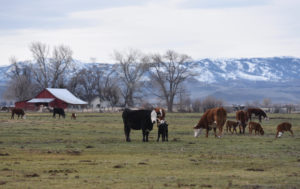
WRANGLING THE LIFESTYLE
For a deeper look inside the ranching lifestyle, “Cowboys” includes a woman’s perspective. The camera crew visited me and my family at our remote cow camp home while we lived in Arizona. I shared my experiences of living four hours from town with no clothes dryer, an unreliable power supply, and two small children. Footage of me taking laundry off the line and my kids twirling on a tire swing in the golden late afternoon light are featured alongside the cowboy crew branding calves through white clouds of dust.
“Outside of interviews, we did not stage a single scene in this movie,” says Force.
This staunch adherence to the truth results in a movie that is gritty, raw, and wholly authentic. It captures a snake-bit horse, rows of cattle carcasses bloated and blackened by wildfire, and a family’s grief over their young son’s death from a ranching accident.
“It’s a privilege to be out here,” says one cowboy. “But you pay a price.”
For those willing to assume the risks, the big outfit lifestyle also provides plenty of unexpected levity alongside the darkness. “Cowboys” includes a montage of bronc rides, punctuated with photographs of a cowboy mid-air and a trio of horseback gents with their heads thrown back in laughter. Langmore’s black-and-white still images are regularly interspersed throughout the movie, inviting the viewer to quietly deliberate the livestock, gear, and rugged scenery along with the interview subjects.
“We wanted to convey how deeply these men and women reflect on their lifestyle,” says Langmore.
In addition to the workload and the livestock, the landscape of ranch country greatly shapes the lifestyle and character of the contemporary working cowboy. The film includes both moving and still images of the vast sagebrush flats, steep mountains, and rocky canyons where cowboys live and work every day. The combination of stunning aerial footage and an impressive original musical score that swells and falls with the canyon walls draws the viewer deeply into film’s beauty.
Cowboys may live far from town in the wide-open spaces, but they have modernized to some degree since the days of the cattle drives. Despite cell phones, WiFi, and indoor plumbing, men and women still earn a living by taking care of cattle with a horse and saddle. One of the movie’s cowboy storytellers summed up the film’s everlasting theme:
“They’ve been talkin’ about the cowboy dyin’ for over 100 years, ever since the trail drive days. But, he’s still here, and always will be.”
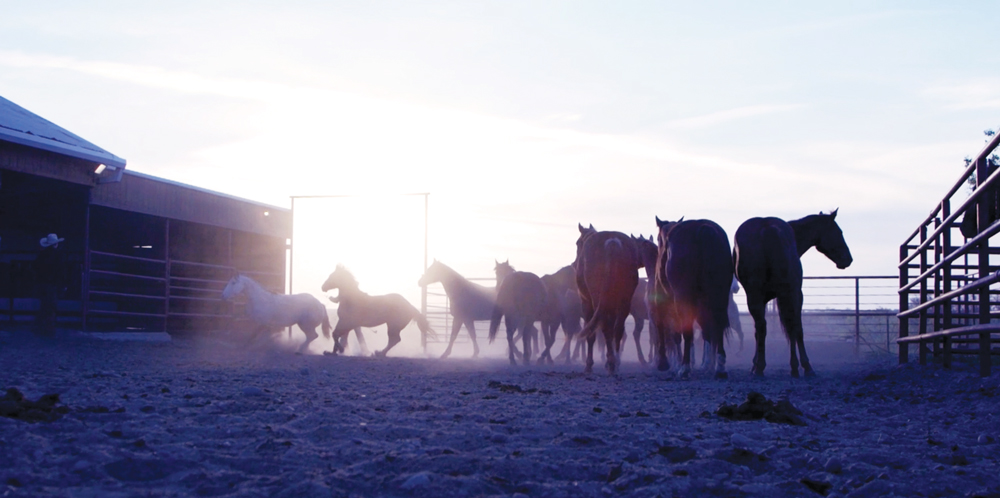
COMING TO NEVADA
After making its rounds on the film festival circuit, it won the audience choice award at the Austin and Rockport Film Festivals. “Cowboys” is set to venture to Nevada for a public screening at the 2020 National Cowboy Poetry Gathering in Elko, Jan. 27-Feb. 1. Local ranches featured in the film include the Spanish Ranch and the YP, both located north of Elko. Along with the “Span,” as it is commonly called, the film also features still images from the TS Ranch, located near Beowawe.
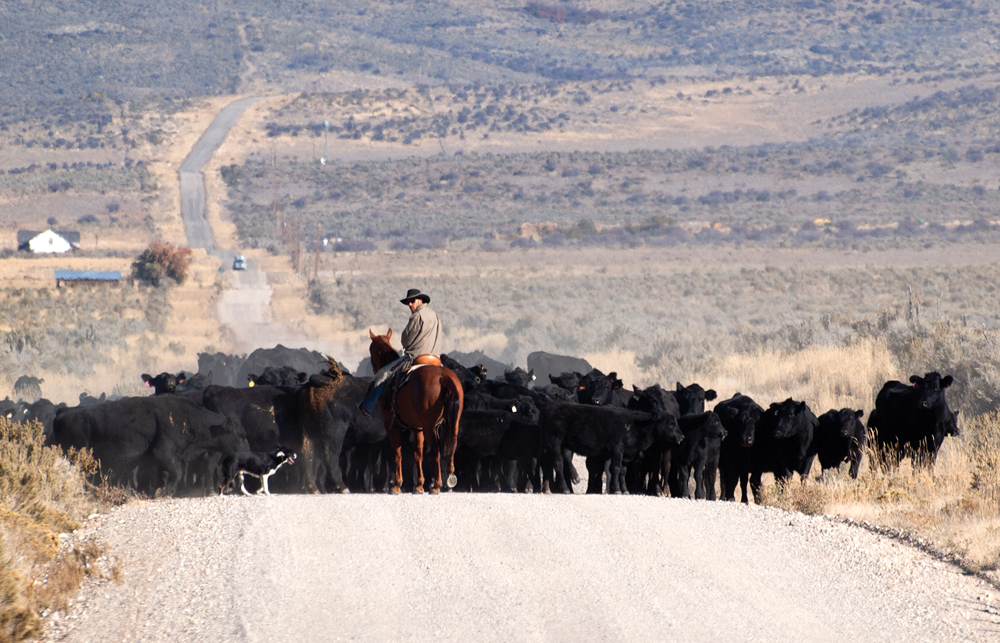
Several local buckaroos are featured prominently in the movie. Ira Wines of the Spanish Ranch provides spoken insight into the cowboy subculture. Greg Snow, cowboss of the YP, also provides substantial narration throughout the film. Native buckaroo Woody Harney is interviewed alongside his son, Junior. Both are employed at the Span, where they continue the family tradition of roping and riding bucking horses every day.
To experience the scenic locations and traditional lifestyle featured in the film, visitors can drive past (or through, in some cases) the historic ranches featured in the film. The roads are rough and dusty, but those willing to make the drive from town will not be disappointed. A trek will be rewarded with scenic vistas of cattle grazing on native hay meadows, ranch headquarters that spring up like unexpected neighborhoods in the middle of nowhere, and centuries-old wooden barns still in everyday use.
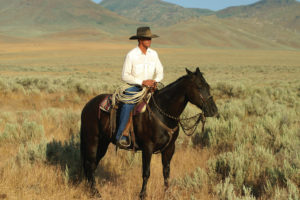
There’s a good chance of seeing real cowboys in action, too. Cowboys often drive cattle down the main roads, so you just might get up close to someone featured in the movie. If you’re feeling friendly, roll down your window and say hi. Cowboys that far from town are usually up for fresh conversation with someone who doesn’t live in the same bunkhouse as they do.
WATCH IT
“Cowboys” can be seen at select screenings throughout the first part of 2020. Later, it will be available on DVD, BluRay, and streaming services. For more information, visit thecowboymovie.com or check nationalcowboypoetrygathering.org for screening details.
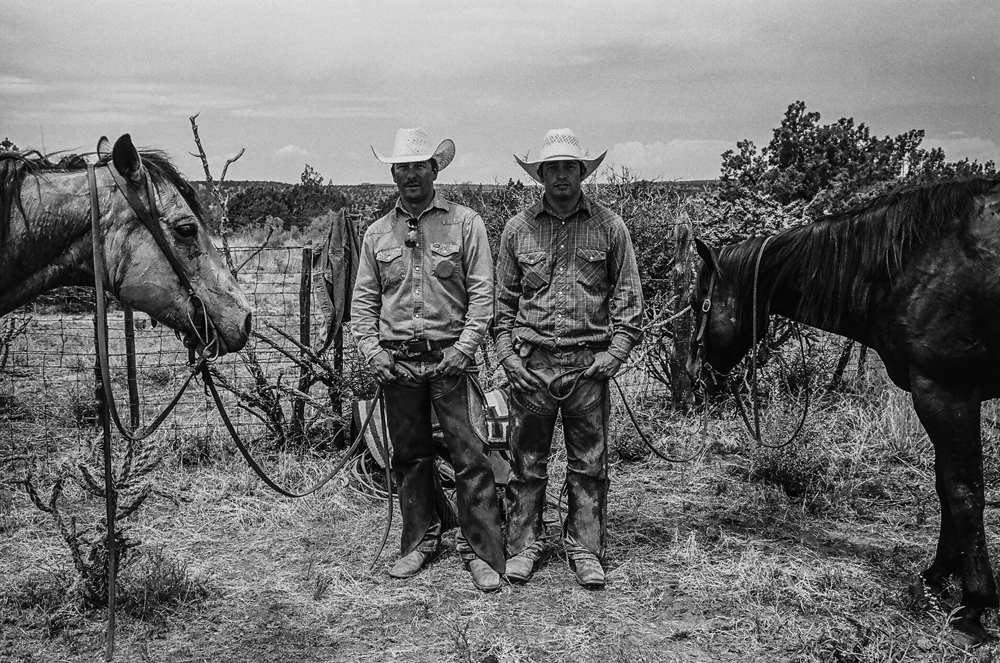 ‘Open Range’
‘Open Range’
Photo book portrays the working cowboy from the bunkhouse to the branding corral.
BY JOLYN YOUNG
Acclaimed photographer John Langmore’s latest book, “Open Range,” far surpasses all expectations of quality coverage of the working cowboy and his lifestyle. Langmore has long photographed ranches around the West, some of which he worked on as a cowboy in his younger years. His work is known worldwide for accurately depicting the American cowboy at work, leisure, and home—usually in a bunkhouse.
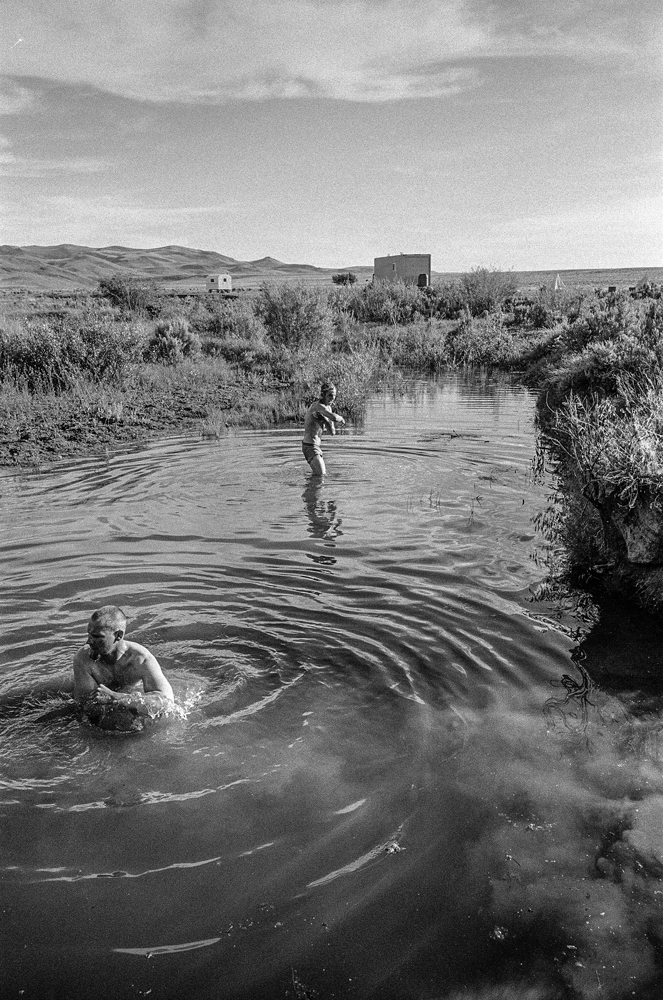 For “Open Range,” Langmore spent 6 years shooting all 4 seasons on 14 of the nation’s most historic ranches. He visited Nevada several times, capturing scenes from the Spanish, TS, and YP Ranches. While at these historic locales, Langmore used his analog camera and cowboy intuition to capture more than what meets the eye. A scene of two cowboys standing beside their saddled horses, covered in sweat and dirt, conveys the tiredness felt by all four. In another image, long-sleeve shirts and blue jeans decorate a tree while a nearby dirt tank welcomes a crew of cowboy-hat-clad swimmers. All his pictures were made with black and white film, a medium that conveys the timeless nature of the working cowboy’s lifestyle.
For “Open Range,” Langmore spent 6 years shooting all 4 seasons on 14 of the nation’s most historic ranches. He visited Nevada several times, capturing scenes from the Spanish, TS, and YP Ranches. While at these historic locales, Langmore used his analog camera and cowboy intuition to capture more than what meets the eye. A scene of two cowboys standing beside their saddled horses, covered in sweat and dirt, conveys the tiredness felt by all four. In another image, long-sleeve shirts and blue jeans decorate a tree while a nearby dirt tank welcomes a crew of cowboy-hat-clad swimmers. All his pictures were made with black and white film, a medium that conveys the timeless nature of the working cowboy’s lifestyle.
Included within “Open Range’s” 144 pages are 30 pages of text that simultaneously educate and entertain. Langmore’s writing is rooted in his childhood summers spent working as a cowboy on a Montana ranch, making him uniquely positioned to tell the story of the modern-day big outfits. He hung up his spurs in his twenties, choosing to use his freshly-earned law degree to make a living. Throughout the ensuing decades, Langmore has actively maintained his ties to ranches and the cowboy community at large.
In his book, Langmore writes about branding calves, cutting colts, camping out with the wagon, running mustangs, eating in the cookhouse, and buck-offs he survived. He explains the modern cowboy code in a way that merits the cowboys’ approval and remedies the city slicker’s ignorance.
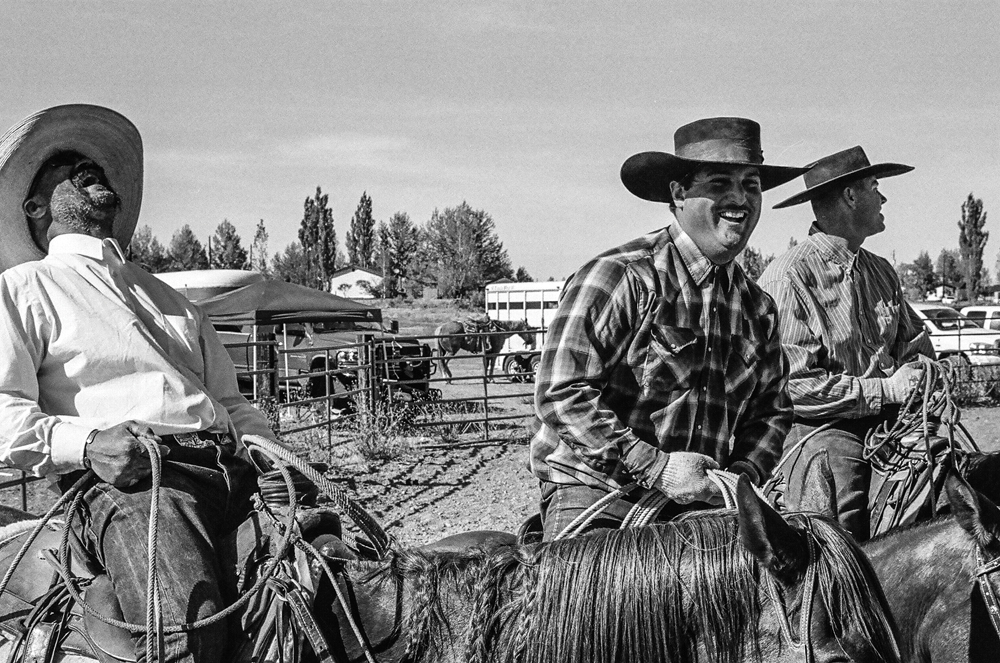 “The next rule you’re likely to confront is more contemporary than traditional, as it governs the order in which horses are loaded into a trailer. First, deference is given to where in the lineup the cow boss or buckaroo boss wants his horse. You basically look to him to tell you it’s okay to load your horse…To understand the rule’s significance, imagine a bunch of siblings stuck in the back seat of a car kicking and biting each other with a thousand pounds of force.”
“The next rule you’re likely to confront is more contemporary than traditional, as it governs the order in which horses are loaded into a trailer. First, deference is given to where in the lineup the cow boss or buckaroo boss wants his horse. You basically look to him to tell you it’s okay to load your horse…To understand the rule’s significance, imagine a bunch of siblings stuck in the back seat of a car kicking and biting each other with a thousand pounds of force.”
The cowboy/photographer/lawyer deftly weaves humor into his stories as well.
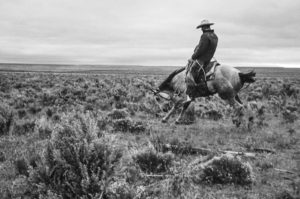 “Another time, I ill-advisedly got on a horse I had no chance of riding. He made that point by bucking me off in two jumps and then kicking me in the chest for good measure. Afterwards, Benny begrudgingly drove me to the Miles City hospital. After examining me, the doctor said that if the kick had landed a few inches differently in either direction, the results might have been altogether more disastrous. Benny dismissively replied, ‘Ah, those doctors always say it could have been worse.’ ”
“Another time, I ill-advisedly got on a horse I had no chance of riding. He made that point by bucking me off in two jumps and then kicking me in the chest for good measure. Afterwards, Benny begrudgingly drove me to the Miles City hospital. After examining me, the doctor said that if the kick had landed a few inches differently in either direction, the results might have been altogether more disastrous. Benny dismissively replied, ‘Ah, those doctors always say it could have been worse.’ ”
Langmore optimistically chronicles the cowboy’s enduring presence in American society.
“New technology…may alleviate the need for some long rides, but nothing can track a cow like a horse. And no amount of modern breeding can remove a cow’s unique ability to hide in a stand of brush or turn on a dime in an effort to undermine man’s efforts to control her destiny.”
For more information or to order a copy of “Open Range” directly from the publisher, visit Twin Palms Publishers.
twinpalms.com, 505-988-5717

